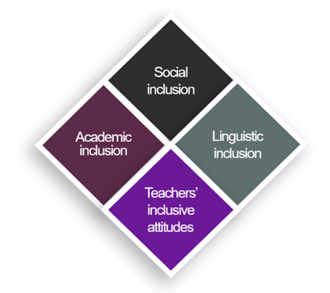Blog: How Do You Create an Inclusive Language Policy in an International School?
In this blog, trainer and subject expert, Tom Beakes, takes a look at the four dimensions that are key to building an inclusive language policy.
The role of languages in international education is key. Why? Because modern international schools are a melting pot of cultures “somewhat precariously suspended within a host culture”, as Nordmeyer nicely puts it. With these schools now facing increasing calls to engage in the work of diversity, equity, inclusion, and justice, many have started to question the assumptions, values, and ideologies in their language policies*.
In this blog, I explore how we might create a language policy that acknowledges and addresses these issues and allows multilingual students and staff the same opportunities to succeed as their monolingual peers.
What do we mean by inclusivity in an EAL context?
Issues such as the position of English in relation to other languages, the value placed on first language speakers of English, and the presence (or lack) of the local culture within the school may put plurilingual learners of English at a disadvantage.
But what do we mean by inclusivity? Inclusion has become one of those buzzwords that appears in education and quickly becomes so widely used and amorphous that it can obscure the clarity of its original purpose. At the organisational level, one understanding is to contrast segregation, where multilingual students are taught separately to their first-language English peers; integration, where multilingual students are placed in English medium classrooms without any support; and inclusion, where all pupils are educated in regular classrooms with appropriate adjustments to allow them to succeed.
Most international schools are blending these three approaches for a diverse range of reasons, some ideological, some practical, which may be difficult to change. For this reason, it is important to avoid a dogmatic application of inclusion without careful consideration of the constraints and opportunities that are unique to each school. Indeed, inclusion without appropriate resourcing in terms of teacher expertise and knowledge can easily become actively harmful to the social and academic success of plurilingual learners.
An inclusive policy should therefore map out how adjustments are applied consistently across the school to minimise segregation and integration. It should outline how effectiveness of English as an Additional Language (EAL) provision is monitored, so that these adjustments can be continually refined and developed to meet the changing needs of the pupils and staff of the school. It is important to acknowledge that there is no one perfect or “best practice” approach, only what works best for each school within its particular context. An inclusive language policy should provide a platform to discover and optimise effective practice across the school.
What makes a language policy inclusive?
A useful way of thinking about inclusive EAL provision is provided by Evans et al. who describe four dimensions of inclusivity in the multilingual classroom (see diagram below). Let’s take a look at each one and consider some examples of how these dimensions might inform decisions on policy content (although, these examples are by no means exhaustive!).

It’s key to remember that, while each dimension is important, academic, social, and linguistic inclusion are all underpinned by the inclusive attitudes of teachers themselves. A language policy that addresses each of these four dimensions is likely to provide a robust platform for the inclusion of plurilingual learners in all areas of their school life.
But, of course, having a language policy is only worthwhile if it is a living document that is read, understood, updated, and implemented. We can view a language policy as an expression of school identity. A language policy that confidently describes your school’s identity and clearly articulates what that means to staff (and students) can be a powerful foundation for building an inclusive school culture that allows plurilingual pupils to thrive.
If you would like to explore more deeply how to develop impactful and inclusive EAL provision within your school, sign up to our upcoming course, EAL Coordinators: Organising Impactful EAL Provision, which starts on 10 September 2024.
*A language policy typically sets out the principles and practices for multilingual provision and the role of languages in the school and classroom environment.
